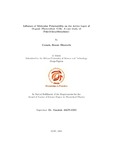| dc.contributor.author | Cornah, Bennie Elizabeth | |
| dc.date.accessioned | 2017-05-12T11:05:04Z | |
| dc.date.available | 2017-05-12T11:05:04Z | |
| dc.date.issued | 2013-05-13 | |
| dc.identifier.uri | http://repository.aust.edu.ng:8080/xmlui/handle/123456789/578 | |
| dc.description.abstract | The complexity of the microstructure of the active layer in organic photo- voltaics (OPVs) poses a unique challenge in improving the efficiency of OPV
devices. Molecular dynamics (MD) simulation provides a direct route to determining this microstructure. However, for a donor material like poly (3- hexylthiophene), (P 3HT ) n , approximations made in all previous force field for MD simulation has been the neglect of explicit polarization. We looked at
the morphology of (P 3HT ) n using MD simulations at different temperatures where we confirmed the semi-crystalline behavior of P3HT between temper- atures of 300 K and 400 K. In line with this, we developed force fields from ab initio data with and without inclusion of explicit molecular polarizability for dimers of (P 3HT ) 1 with monomers optimized at the MP2/cc-pvtz level. | en_US |
| dc.description.sponsorship | AUST | en_US |
| dc.language.iso | en | en_US |
| dc.subject | Cornah Bennie Elizabeth | en_US |
| dc.subject | Dr Akin-Ojo Omololu | en_US |
| dc.subject | Poly(3-hexylthiophene) | en_US |
| dc.subject | Organic Photovoltaic Cells | en_US |
| dc.subject | Molecular Polarizability | en_US |
| dc.subject | 2013 Theoretical Physics Theses | en_US |
| dc.title | Influence of Molecular Polarizability on the Active Layer of Organic Photovoltaic Cells: A case study of Poly(3-hexylthiophene) | en_US |
| dc.type | Thesis | en_US |

